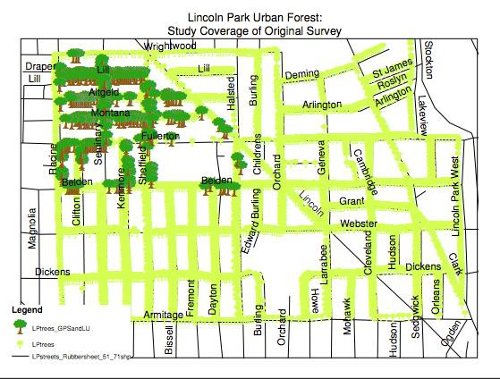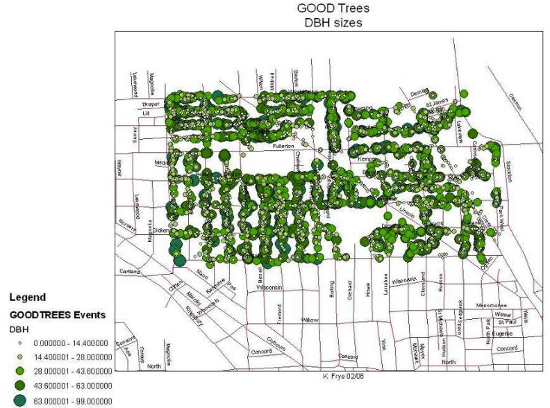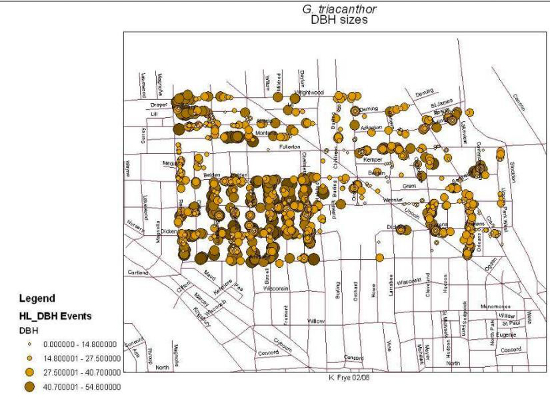- 00:00Panoramica
- 02:09Principles of Urban Forestry and GIS
- 04:54Tree Location, Size, and Condition Data Collection
- 06:04Entering Data into GIS
- 08:43The National Tree Benefits Calculator
- 09:32Applications
- 10:29Summary
GIS를 사용한 도시 임업 조사
English
Condividere
Panoramica
출처: 마가렛 노동자와 킴벌리 프라이의 실험실 – 데폴 대학
도시 숲에는 도시 공원, 가로수, 조경된 대로, 공공 정원, 강 및 해안 산책로, 그린웨이, 강 복도, 습지, 자연 보호구역, 자연 지역, 나무 보호소, 산업용 브라운필드 부지의 작업 나무 등이 광범위하게 있습니다. 도시 나무의 역사는 풍경 장식으로 나무로 시작됩니다. 오늘날 도시 나무는 도시 인프라의 필수 구성 요소로 간주되며 식량, 주택 및 기타 공공 시설로서 인간의 삶에 매우 중요합니다. 도시 나무는 이제 그들이 제공하는 생태계 서비스(예 : 침식 방지, 대기 오염 물질 제거, 산소, 그늘 등)에 대한 평가됩니다. 그러나 이러한 이점을 효율적으로 활용하려면 잎 수와 크기가 생태계 서비스를 제공하는 나무의 능력에 직접적인 영향을 미치기 때문에 나무가 성숙에 도달해야 합니다. 도시 임업은 삼림 지대에 비해 도시 나무에 고유 한 요구와 도전을 해결하기 위해 자체 임업 방법을 개발했다.
USDA 산림청에서 발췌한 다음 내용은 연방 정부의 도시 나무 관점과 정책을 보여줍니다.
도시 숲은 공기와 물을 청소하고, 폭풍우를 제어하고, 에너지를 보존함으로써 필요한 환경 서비스를 제공하는 역동적인 생태계입니다. 그들은 도시 디자인에 형태, 구조, 아름다움 및 호흡 공간을 추가하고, 소음을 줄이고, 호환되지 않는 별도의 용도를 사용하고, 사회 응집력을 강화하고, 지역 사회 활성화를 활용하고, 지역 사회에 경제적 가치를 더할 수있는 장소를 제공합니다… 이 자연 생활 지원 시스템은 깨끗한 공기와 물, 생물 다양성, 서식지, 중첩 및 야생 동물을위한 여행 복도를 유지하고 사람들을 자연과 연결합니다.
도시 나무의 관리는 건축, 조경, 계획, 개발, 원예 등을 포함하는 학제 간 관행입니다. 임업과 관련된 한 가지 특별한 분야는 지리이며, 특히 지리 정보 시스템(GIS)을 사용하는 것입니다. GIS는 지리적 또는 공간 데이터를 포함하는 모든 유형의 데이터베이스를 포괄하는 광범위한 이름으로, 컴퓨터로 생성된 시각적표현(예:지도)을 만드는 데 사용할 수 있습니다. GIS를 사용하면 지속적으로 개선되는 사용자 인터페이스를 통해 광범위한 데이터 수집 및 관리를 통해 많은 사용자가 액세스할 수 있는 매우 큰 정보 집합의 사용자 친화적인 품질을 높일 수 있습니다. GIS 애플리케이션은 무료 소프트웨어 및 오픈 액세스 프로토콜(예: Google 어스)부터 ESRI ArcGIS와 같은 독점 시스템에 이르기까지 다양합니다. GIS를 사용하여 지리적 정보를 만들고 저장하면 데이터베이스에 새 정보를 추가하고 시각적 출력을 재생하여 맵을 신속하게 업데이트할 수 있으므로 데이터 유지 관리가 용이합니다.
Principi
Procedura
Risultati
Figure 1 shows the representative results for street trees found on one block, and a map from urban forestry data entered into GIS can be seen in Figure 4.
The results for using the Tree Benefit Calculator can be found in Table 2. This calculator provides an estimation of the benefits individual street-side trees provide. Once the data from the field investigation is inputted, including zip code, species, diameter, and land-use, the environmental and economic benefit provided by each tree can be seen.

Figure 4. Maps from urban forestry data entered into GIS.
| Tree Sample Number | Overall Benefit | Storm Water Management (gallons) |
Property Value | Energy Efficiency (kW/hr) |
Carbon Sequestration (lbs) |
| 1 | $20 | 173 | $4 | 38 | 109 |
| 2 | $24 | 217 | $8 | 41 | 133 |
| 3 | $22 | 161 | $11 | 27 | 113 |
| 4 | $11 | 69 | $2 | 22 | 74 |
| 5 | $46 | 356 | $22 | 56 | 169 |
Table 2. The Tree Benefit Calculator results.
Applications and Summary
Once entered into a GIS, forestry data can be analyzed using geospatial statistics. For example, a Moran’s I geospatial statistical test is a widely used statistic that analyzes for significant geographical clustering of health variables. Moran’s I can be used for forestry data to report dbh values localized to particular areas, indicating different tree growth rates in different locations of the forest. If clustering is significant, a General G geospatial statistical test can additionally reveal whether it is the high or low values that are geographically clustered by reporting which end of the clustering values are concentrated in a geographical area (Figure 5). Significant Moran's I clusters are shown with the General G scores, indicating high dbh values clustered for the good trees and for each species. dbh values are represented by proportionally-sized symbols to illustrate the clustering of high values (large circles) and low values (small diamonds) (Figure 6). Features can be paired in maps to look for meaningful patterns, such as dbh and species, to identify which species tend to grow to maturity more successfully in an urban environment. Clusters of high dbh values indicate older trees that may present near future needs for tree removal or a higher risk area for tree damage caused by storms. High dbh clusters may also indicate areas where trees survive longer and regions of a city receiving higher ecosystem service benefits.

Figure 5. Clusters of dbh sizes for good trees on a map.

Figure 6. High dbh clusters identified on a map.
Trascrizione
Urban forests are valuable resources, and require care and management to ensure their health. The distribution of trees, their condition, and the scale and shape of urban forests can be mapped using GIS, or Geographical Information System, software.
Trees in urban areas may range from simple street trees to landscaped boulevards, greenways, public gardens, or those at industrial brownfield sites. Combined, these urban forests are essential components of city infrastructure. Urban forestry uses novel methods to address the needs and challenges unique to urban trees.
Urban forests fill valuable environmental niches, acting to clean air and water, control storm waters, prevent erosion, reduce noise, and conserve energy. Additionally, urban forests can provide important habitats for animals, provide shelter for nesting, or act as travel corridors for wildlife. Their value can also be social, connecting urban inhabitants to nature, enhancing architecture, and providing educational opportunities to learn about nature.
The structure, diversity, and resultant ecological value of urban forests can be quantified using GIS, or Geographical Information Systems, software. GIS allows for extensive data collection and management, which is an ideal framework for compiling urban forestry data. GIS allows users to combine geographical and tree-survey data to produce accurate maps of urban forests.
This video will illustrate the process of collecting tree survey data, incorporating this data into a GIS platform, and evaluating the environmental value of trees of interest.
Urban forest surveys may be conducted at a variety of locations. Commonly, parkway trees planted between sidewalks and curbs are recorded. Data is typically collected by city block, and records tree location, species, health, land use, and diameter at breast height, or DBH.
Tree condition is a visual assessment based on six categories. These are trunk condition, which takes into account factors including missing bark or decay; growth rate, examining twig elongation and length of current year’s growth; and structure, taking note of dead or broken limbs. Insects and disease are noted; crown development, which assesses trees for a balanced appearance of branches, leaves, and reproductive structures; and finally life expectancy, based on the life expectancy for the species, minus the damage present.
Each category carries a rating system, based on the amount of unhealthy tree features summed together, which combined give an overall condition score for a tree. This can be attributed to a categorical tree health measurement ranging from excellent down through very good, good, fair, poor, to very poor.
A GPS receiver, which uses satellite positioning transmitted to the handset allows the user to record geodesic coordinates of latitude and longitude. Location is also noted by postal address. Once collected, data can be entered into a GIS software program, which allows spatial and geospatial statistical analysis of trees and tree characteristics. There are several such programs available, including ArcGIS or Google Earth.
The National Tree Benefits Calculator is a free online software tool that is used to provide an economic estimation of the monetary benefits provided by urban and suburban trees. Here, users can select their survey region, and choose from a list of trees in that area. Inputting a few simple details including tree trunk diameter and land-use type, will give an estimation of the value of the tree in several key areas, including property value, air quality, and storm water control.
Now that we are familiar with the concept of urban forestry surveys and the principles behind them, let’s take a look at how these are carried out in the field.
To begin the survey, select a suitable outdoor location and turn on the GPS receiver. Wait for it to connect to satellites and detect the location. Proceed to the start of the survey area selected for data collection. Survey one city block segment at a time. At each tree encountered, record the species using this collection’s video on Tree Identification. Also record the longitude and latitude provided by the GPS receiver, and postal address.
Next, measure the diameter of each tree at 4.5 ft above the ground, which is taken as the diameter at breast height, or DBH. Assign each tree a number, resetting the numbering at the start of each block segment.
Observe the condition of each tree by visually estimating and scoring according to the criteria presented in the table shown. Sum the points to obtain an overall score for each tree, and assign each a corresponding health category.
Two programs that can be used to compile GIS data are Google Earth or ArcGIS. Using these programs, trees can be place-marked individually or their coordinates complied into a single file and uploaded.
To use the Google Earth GIS program, type in the tree coordinates and select new placemark, using the “Add Placemark” feature. Name each tree by species name, and once all tree data points are saved as placemarks, right click on the “My Places” label, select “Save As”, then save to any location.
To use the ArcGIS program, when importing data endure all column headings are free of spaces. Underscores can be used instead. If the coordinates are in latitude and longitude format, they should be converted to decimal degrees format before import into ArcGIS.
Save the data as a comma-delimited CSV file. Next, create a layer by adding the CSV file to ArcMap using the Add Data tool, either under File: Add Data, or by clicking the “Add Data” tool on the standard toolbar.
Right-click on the new layer and choose “Display XY Data”. Ensure that the X, or longitude, and Y, or latitude, fields were selected correctly by ArcMap.
Next, click “Edit”, then “Select” to highlight the coordinate system for the points, then “Add”, and “OK”. The correct coordinate system to use can be obtained from the GPS unit itself.
There should now be a point layer at the top of the Table of Contents with the same name as the CSV file, and the word “Events” at the end of the name. This is an “event theme”, and is a temporary layer. To make a permanent copy, right-click on the layer and choose “Data” then “Export Data”. Pick an output location and enter a file name. Change the name from the default “Export Output” to “Urban_Forestry_Survey” and click “OK”.
Data entered into the ArcGIS program will produce a map of urban forestry data. These maps can be used in a number of ways, including identifying patterns of DBH sizes, or determining if trees in a particular area are not reaching life expectancy.
Open up the iTree for Education software tool. For each tree, input the relevant data, and record the environmental benefits for each tree. Estimated benefits of urban trees can be calculated and assigned monetary values. This includes a tree’s annual benefits for storm water management, property value, energy efficiency, and carbon sequestration.
The results from analysis with the National Tree Benefit Calculator can give a summary of the economic and environmental value of the trees surveyed. This can allow urban planners to decide upon any tree removals, or supplementary plantings that may benefit the area surveyed.
Urban Forestry maps can be used in a variety of applications, and some of these are explored here.
In urban residential or suburban areas, urban forestry will often have different requirements from trees than those in commercial or retail areas. Trees may be protected or selected for planting based on similar ecological properties such as wind or noise barriers, or water management concerns. However, aesthetic value may play a greater part in residential forestry.
Geographical Information Systems can also be used to map many other phenomena, natural or manmade. GIS maps of natural measurements of lead levels in soil can also be compiled and used to determine contamination levels, or safe versus unsafe regions for planting of food crops.
You’ve just watched JoVE’s introduction to Urban Forestry using GIS. You should now understand the importance of urban forestry, how to use GIS to create maps for the study of urban trees, and how to use the National Tree Benefit Calculator to ascertain the value of surveyed trees. Thanks for watching!
